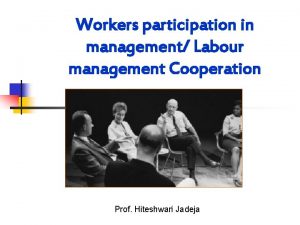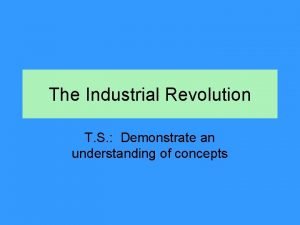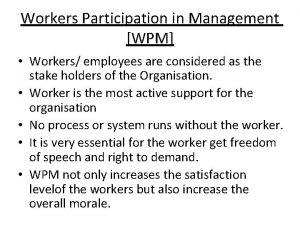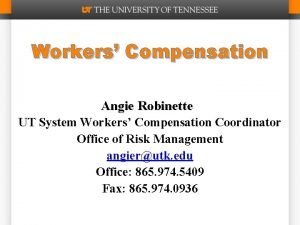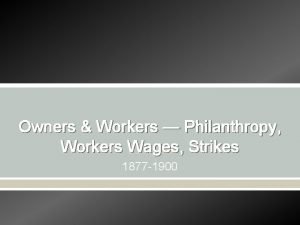Levels of Workers Participation Levels of Participation 1






















- Slides: 22

Levels of Worker’s Participation

Levels of Participation 1. 2. 3. 4. 5. 6. 7. 8. Collective Bargaining Works Committees Shop / Department Council Joint Councils Board Representations Workers Ownership of Enterprise Quality Circles Kaizen

1. Collective Bargaining ILO has defined, "Collective bargaining as, negotiation a bout working conditions and terms of e mployment between an employer and a group of employees or one or more employee, organization with a view to reaching an agreement wherein the terms serve as a code of defining the rights and obligations of each party in

• • Collective : -because both the employer and the employee act as a group rather than as individuals. Bargaining : because the method of reaching an agreement involves proposals and counter proposals, offers and counter offers and other negotiations.

• Thus collective bargaining: – is a continuous process which aims at establishing stable relationships between the parties involved. – is a collective process in which representatives of both the management and employees participate. – not only involves the bargaining agree ment, but also involves the implement ation of such an agreement.

• Loopholes in Collective Bargaining The process of CB cannot be called WPM in its strongest sense as in reality; CB is based on the crude concept of exercising power for the benefit of one party. – WPM, on the other hand, brings both the parties together and develops appropriate mutual understanding and –

2. Works Committees • • • Under the Industrial Disputes Act, 1947, every establishment employing 100 or more workers is required to constitute a works committee It consists of equal number of representatives from the employer and the employees. The main purpose of this committee is to provide measures for securing and preserving amity and good relations

Functions of Work Committee • Works committee deals with matters of day-to-day functioning at the shop floor level. Works committees are concerned with: – – Conditions of work such as ventilation, lighting and sanitation. Amenities such as drinking water, canteens, dining rooms, medical and health services. Educational and recreational activities. Safety measures, accident prevention mechanisms etc.

• • Loopholes in Works Committees Lack of competence and interest on the part of workers’ representatives. Employees consider it below their dignity and status to sit alongside blue-collar workers. Lack of feedback on performance of Works Committee. Undue delay and problems in

• • • 3. Shop / Department Council Government of India on the 30 th of October 1975 announced a new scheme in WPM. In every Industrial establishment employing 500 or more workmen, the employer shall constitute a shop council. Shop council represents each department or a shop in a unit.

• • The employers’ representatives will be nominated by the management and must consist of persons within the establishment. The workers’ representatives will be from among the workers of the department or shop concerned. The total number of employees may not exceed 12. All decisions taken will be

Functions of Shop Council • • Assist management in achieving monthly production targets. Improve production and efficiency, including elimination of wastage of man power. Study absenteeism in the shop or department and recommend steps to reduce it. Suggest health, safety and welfare measures to be adopted for smooth functioning of staff.

4. Joint Councils • • • The joint councils are constituted for the whole unit, in every Industrial Unit employing 500 or more workers. Only such persons who are actually engaged in the unit shall be the members of Joint Council. A joint council shall meet at least once in a quarter. The chief executive of the unit shall be the chairperson of the joint council. The vice-chairman of the joint council

• • It for a period of two years. The decisions will be binding on both parties and will be implemented within one month. In 1977 the above scheme was extended to the PSUs like commercial and service sector organizations employing 100 or more persons. The organizations include hotels, hospitals, railway and road transport, post and telegraph offices, state

Functions of Joint Council • • Fixation of production norms Work planning Achieving production targets Training Reward policy Creative suggestions Health Security

• • 5. Board Representation This would be the highest form of industrial democracy. The workers’ representative on the Board can play a useful role in safeguarding the interests of workers. The worker can serve as a guide and a control element. The worker can prevail top

• • Loopholes of Board Representation Focus of workers’ representatives is different from the focus of the remaining members of the Board The worker tends to become alienated from the workers. The worker may be less effective with the other members of the Board in dealing with employee matters. Due to the differences in the cultural , educational backgrounds and behaviour, the employees’ representative may feel inferio r to the other members, and may feel

6. Worker’s Ownership Of Enterprise This involves making the workers’ shareholders of the company by inducing them to buy equity shares. • In many cases, advances and financial assistance in the form of easy repayment options are extended to enable employees to buy equity shares. Examples of this method are available in the manufacturing as well as the service sector. • Advantage: Makes the workers committed to the job and to the organization. •

7. Quality Circles(QC) • It consists of seven to ten people from the same work area who meet regularly to define, analyze, and solve quality and related problems in their area. • These circles require a lot of time and commitment on the part of members for regular meetings, analysis, brainstorming etc • Most QCs have a definite life cycle – one to three years. Few circles survive beyond this limit either because they loose steam or they face simple problems. • QCs can be an excellent bridge between

Advantages of QC • • • Employees become involved in decision-making, acquire communication and analytical skills and improve efficiency of the work place. Organization gets to enjoy higher savings-to-cost ratios. Chances of QC members to get promotions are enhanced

8. Kaizen • • • It is also called as “Continuous Improvement” It is a policy of constantly introducing small incremental changes in a business in order to improve quality and/or efficiency. This approach assumes that employees are the best people to identify room for improvement, since they see the processes in action all the time.

Features of Kaizen • • • Improvements are based on many, small changes rather than the radical changes that might arise from Research and Development As the ideas come from the workers themselves, they are less likely to be radically different, and therefore easier to implement Small improvements are less likely to require major capital investment than major process changes The ideas come from the talents of the existing workforce, as opposed to using R&D, consultants or equipment – any of which could be very expensive All employees should continually be seeking
 Workers participation in management
Workers participation in management Workers participation in management
Workers participation in management Simbol lrs
Simbol lrs 5 levels of participation
5 levels of participation Level 3 question example
Level 3 question example Workers of the world, unite!
Workers of the world, unite! Evidence of textile workers in wilson’s mill
Evidence of textile workers in wilson’s mill Health informatics skills
Health informatics skills Oregon workers compensation division
Oregon workers compensation division C.d.c. covid isolation health workers
C.d.c. covid isolation health workers Office workers admit being rude
Office workers admit being rude Parable of the workers in the vineyard powerpoint
Parable of the workers in the vineyard powerpoint National association of forensic social workers
National association of forensic social workers Scientific selection procedure
Scientific selection procedure Child workers some as young as 10
Child workers some as young as 10 Altar worker job description
Altar worker job description Mobile workers definition
Mobile workers definition Atypical worker meaning
Atypical worker meaning Texas hcn workers compensation
Texas hcn workers compensation The factory workers were ready able
The factory workers were ready able How did henry ford treat his workers
How did henry ford treat his workers Identify the independent variable and dependent variable
Identify the independent variable and dependent variable Basic training for barangay health workers
Basic training for barangay health workers
